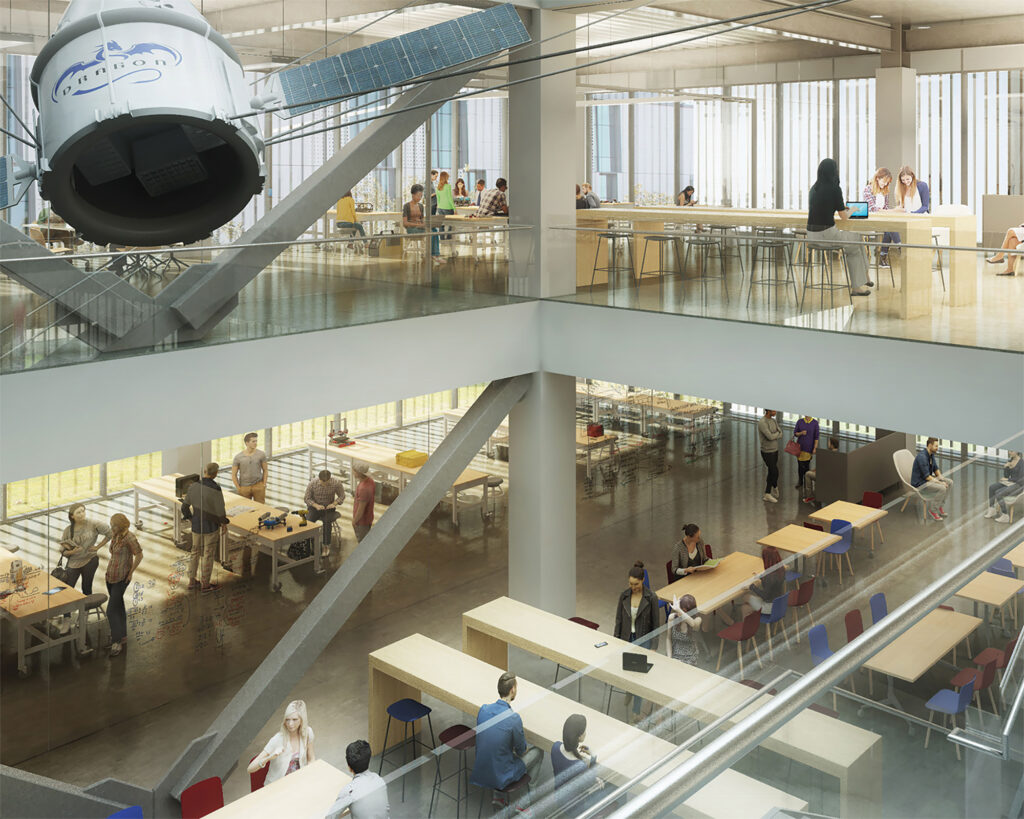
The tradition of robust education provided by the LMU Frank R. Seaver College of Science and Engineering is on track for a major enhancement. A top priority of the next LMU comprehensive fundraising campaign, which is now in a quiet phase, is the Engineering Innovation Complex.
The EIC will replace Pereira Hall, built in 1954, along the newly imagined “Creativity Corridor,” which includes, among other facilities, the Bruce Featherston Life Sciences Building and another major campaign capital project, the future Performing Arts Pavilion. Featuring best-in-class facilities for research, learning, and discovery, the facility will support interdisciplinary research programs and house programs in engineering, computer science, physics, and health care systems engineering.
The Engineering Innovation Complex will further tie Seaver programs to innovation.
With more than 83,000 sq. ft. across two buildings — one resembling a cube and the other a bar or rectangle — the complex will feature 10 interactive classrooms, six collaborative open spaces, 35 interdisciplinary teaching and research labs, 28 offices, and five additional support spaces. A module-based layout will provide flexibility for future growth with an ability to reconfigure teaching and research spaces to respond to both changing needs and opportunities for specialized hubs that address key areas for investigation.
“The Engineering Innovation Complex (EIC) will position LMU as a leader in STEM education focused on innovation, creativity, and discovery,” says Tina Choe, dean of the Seaver College. “Building upon the strengths of our programs and faculty, leveraging LMU’s location in Los Angeles at the heart of technology and engineering industries, the EIC will propel interdisciplinary collaborations to tackle the world’s greatest challenges and capture new opportunities.”
The Cube will house all interdisciplinary innovation spaces, advanced makerspaces, and community spaces featuring an “innovation on display” design principle with open workspaces and glass walls to observe activities within.
The Bar will house all classrooms, laboratories, community spaces, and offices. A pedestrian walkway will connect the Cube and the Bar on each of the three floors, and community collaboration zones throughout the complex will promote an environment of connection and discovery. The EIC will also feature an open greenspace courtyard.
“A new EIC will provide access and space for our engineering students to work on interdisciplinary human-centered design activities, including assistive devices through LMU’s Quality of Life Plus (QL+) organization,” says Matt Siniawski, professor and chair of the Mechanical Engineering department. “The space will provide countless opportunities for students from multiple disciplines to come together in an enlivening environment and to facilitate interaction with our community partners to better understand their needs and therefore create better products.”
LMU is committed to raising $110 million towards the cost of the EIC capital project before beginning construction and aims to complete fundraising by December 2025 and begin construction in 2026. To learn more about the EIC, contact Jeanie Kim, interim associate vice president, at jeanie.kim@lmu.edu.
